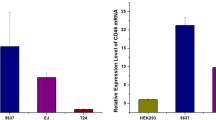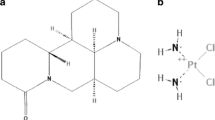Abstract
Bladder cancer-specific oncolytic adenovirus Ad/PSCAE/UPII/E1A, carrying E1A gene regulated by human Uroplakin II (UPII) promoter and prostate stem cell antigen enhancer (PSCAE), could kill bladder tumor cells preferentially. The aim of this study was to examine the effects of Ad/PSCAE/UPII/E1A combined with cisplatin on human bladder cancer cells and to identify the underlying mechanisms. The combined effects of Ad/PSCAE/UPII/E1A and cisplatin on EJ, 5637, and BIU-87 bladder cancer cells were evaluated by MTT cell proliferation assay. Cell apoptosis was detected by flow cytometry with fluorescein isothiocyanate-conjugated annexin V (annexin V-FITC) and propidium iodide staining. The activation of the caspase pathway and the expression of Bcl-2 family proteins were determined by western blot assay. Ad/PSCAE/UPII/E1A adenovirus vector could infect bladder cancer cell lines selectively and induce growth inhibition effectively. Of note, the combination treatment of cisplatin and Ad/PSCAE/UPII/E1A could inhibit the proliferation of bladder cancer cells significantly compared with the “alone” treatment. Furthermore, Ad/PSCAE/UPII/E1A plus cisplatin combined treatment resulted in enhanced apoptosis in bladder cancer cells. The enhanced antitumor effects in vitro elicited by Ad/PSCAE/UPII/E1A plus cisplatin were closely related to the increased Fas expression and cleavage of caspase-8 and Bid and decrease in the ratio of anti- to pro-apoptotic proteins followed by activation of caspase-9 and caspase-3, which may contribute to the activation of extrinsic and intrinsic apoptotic pathways. Our results indicate that the combination of Ad/PSCAE/UPII/E1A with cisplatin exerts a synergistic antitumor effect on human bladder cancer cells and is a potential combined treatment strategy for bladder cancer.







Similar content being viewed by others
References
Inoue K, Perrotte P, Wood CG, Slaton JW, Sweeney P, Dinney CP. Gene therapy of human bladder cancer with adenovirus-mediated antisense basic fibroblast growth factor. Clin Cancer Res. 2000;6:4422–31.
Pan CX, Koeneman KS. A novel tumor-specific gene therapy for bladder cancer. Med Hypotheses. 1999;53:130–5.
Kleinerman DI, Dinney CP, Zhang WW, Lin SH, Van NT, Hsieh JT. Suppression of human bladder cancer growth by increased expression of C-CAM1 gene in an orthotopic model. Cancer Res. 1996;56:3431–5.
Burke JM, Lamm DL, Meng MV, Nemunaitis JJ, Stephenson JJ, Arseneau JC, et al. A first in human phase 1 study of CG0070, a GM-CSF expressing oncolytic adenovirus, for the treatment of nonmuscle invasive bladder cancer. J Urol. 2012;188:2391–7.
Kirn D. Clinical research results with dl1520 (Onyx-015), a replication-selective adenovirus for the treatment of cancer: what have we learned? Gene Ther. 2001;8:89–98.
Ganly I, Kirn D, Eckhardt G, Rodriguez GI, Soutar DS, Otto R, et al. A phase I study of Onyx-015, an E1B attenuated adenovirus, administered intratumorally to patients with recurrent head and neck cancer. Clin Cancer Res. 2000;6:798–806.
Biederer C, Ries S, Brandts CH, McCormick F. Replication-selective viruses for cancer therapy. J Mol Med (Berl). 2002;80:163–75.
Ring CJ. Cytolytic viruses as potential anti-cancer agents. J Gen Virol. 2002;83:491–502.
Heise C, Kirn DH. Replication-selective adenoviruses as oncolytic agents. J Clin Invest. 2000;105:847–51.
Howe JA, Demers GW, Johnson DE, Neugebauer SE, Perry ST, Vaillancourt MT, et al. Evaluation of E1-mutant adenoviruses as conditionally replicating agents for cancer therapy. Mol Ther. 2000;2:485–95.
Hallenbeck PL, Chang YN, Hay C, Golightly D, Stewart D, Lin J, et al. A novel tumor-specific replication-restricted adenoviral vector for gene therapy of hepatocellular carcinoma. Hum Gene Ther. 1999;10:1721–33.
Zhai ZX, Wang ZP, Fu SJ, Lu J, Wang F, Li R, et al. Antitumor effects of bladder cancer-specific adenovirus carrying E1A-androgen receptor in bladder cancer. Gene Ther. 2012;19:1065–74.
Kelland L. The resurgence of platinum-based cancer chemotherapy. Nat Rev Cancer. 2007;7:573–84.
Morton RP, Rugman F, Dorman EB, Stoney PJ, Wilson JA, McCormick M, et al. Cisplatinum and bleomycin for advanced or recurrent squamous cell carcinoma of the head and neck: a randomized factorial phase III controlled trial. Cancer Chemother Pharmacol. 1985;15:283–9.
Williams SD, Birch R, Einhorn LH, Irwin L, Greco FA, Loehrer PJ. Treatment of disseminated germ-cell tumors with cisplatin, bleomycin and either vinblastine or etoposide. N Engl J Med. 1987;316:1435–40.
Reed JC. Mechanisms of apoptosis. Am J Pathol. 2000;157:1415–30.
Dings RP, Yokoyama Y, Ramakrishnan S, Griffioen AW, Mayo KH. The designed angiostatic peptide anginex synergistically improves chemotherapy and antiangiogenesis therapy with angiostatin. Cancer Res. 2003;63:382–5.
Xie Y, Sheng W, Miao J, Xiang J, Yang J. Enhanced antitumor activity by combining an adenovirus harboring ING4 with cisplatin for hepatocarcinoma cells. Cancer Gene Ther. 2011;18:176–88.
Fadok VA, Voelker DR, Campbell PA, Cohen JJ, Bratton DL, Henson PM. Exposure of phosphatidyl serine on the surface of apoptotic lymphocytes triggers specific recognition and removal by macrophages. J Immunol. 1992;148:2207–16.
Zamai L, Falcieri E, Marhefka G, Vitale M. Supravital exposure to propidium iodide identifies apoptotic cells in the absence of nucleosomal DNA fragmentation. Cytometry. 1996;23:303–11.
Chu RL, Post DE, Khuri FR, Van Meir EG. Use of replicating oncolytic adenoviruses in combination therapy for cancer. Clin Cancer Res. 2004;10:5299–312.
Kirn D, Martuza RL, Zwiebel J. Replication-selective virotherapy for cancer: biological principles, risk management and future directions. Nat Med. 2001;7:781–7.
Rodriguez R, Schuur ER, Lim HY, Henderson GA, Simons JW, Henderson DR. Prostate attenuated replication competent adenovirus (ARCA) CN706: a selective cytotoxic for prostate-specific antigen-positive prostate cancer cells. Cancer Res. 1997;57:2559–63.
Matsubara S, Wada Y, Gardner TA, Egawa M, Park MS, Hsieh CL, et al. A conditional replication-competent adenoviral vector, Ad-OC-E1a, to cotarget prostate cancer and bone stroma in an experimental model of androgen-independent prostate cancer bone metastasis. Cancer Res. 2001;61:6012–9.
Kurihara T, Brough DE, Kovesdi I, Kufe DW. Selectivity of a replication-competent adenovirus for human breast carcinoma cells expressing the MUC1 antigen. J Clin Invest. 2000;106:763–71.
Adachi Y, Reynolds PN, Yamamoto M, Wang M, Takayama K, Matsubara S, et al. A midkine promoter-based conditionally replicative adenovirus for treatment of pediatric solid tumors and bone marrow tumor purging. Cancer Res. 2001;61:7882–8.
Peng XY, Won JH, Rutherford T, Fujii T, Zelterman D, Pizzorno G, et al. The use of the L-plastin promoter for adenoviral-mediated, tumor-specific gene expression in ovarian and bladder cancer cell lines. Cancer Res. 2001;61:4405–13.
Tsukuda K, Wiewrodt R, Molnar-Kimber K, Jovanovic VP, Amin KM. An E2F-responsive replication-selective adenovirus targeted to the defective cell cycle in cancer cells: potent antitumoral efficacy but no toxicity to normal cell. Cancer Res. 2002;62:3438–47.
Go RS, Adjei AA. Review of the comparative pharmacology and clinical activity of cisplatin and carboplatin. J Clin Oncol. 1999;17:409–22.
Pan QW, Liu BS, Liu J, Cai R, Wang Y, Qian C. Synergistic induction of tumor cell death by combining cisplatin with an oncolytic adenovirus carrying TRAIL. Mol Cell Biochem. 2007;304:315–23.
Deng XY, Kim M, Vandier D, Jung YJ, Rikiyama T, Sgagias MK, et al. Recombinant adenovirus-mediated p14ARF overexpression sensitizes human breast cancer cells to cisplatin. Biochem Biophys Res Commun. 2002;296:792–8.
Sternberg CN, Yagota A, Scher HI, Watson RC, Ahmed T, Weiselberg LR, et al. Preliminary results of M-VAC (methotrexate, vinblastin, doxorubicin and cisplatin) for transitional carcinoma of the urothelium. J Urol. 1985;133:403–7.
Sternberg CN, Yagota A, Scher HI, Watson RC, Geller N, Herr HW, et al. Methotrexate, doxorubicin and cisplatin for advanced transitional cell carcinoma of the urothelium: efficacy and patterns of response and relapse. Cancer. 1989;64:2448–53.
Arafa e-SA, Zhu Q, Barakat BM, Wani G, Zhao Q, EI-Mahdy MA, et al. Tangeretin sensitizes cisplatin-resistant human ovarian cancer cells through downregulation of phosphoinositide 3-kinase/Akt signaling pathway. Cancer Res. 2009;69:8910–7.
Cheong SC, Wang Y, Meng JH, Hill R, Sweeney K, Kirn D, et al. E1A-expressing adenoviral E3B mutants act synergistically with chemotherapeutics in immunocompetent tumor models. Cancer Gene Ther. 2008;15:40–50.
Takakura M, Nakamura M, Kyo S, Hashimoto M, Mori N, Ikoma T, et al. Intraperitoneal administration of telomerase-specific oncolytic adenovirus sensitizes ovarian cancer cells to cisplatin and affects survival in a xenograft model with peritoneal dissemination. Cancer Gene Ther. 2010;17:11–9.
Wu YM, Zhang KJ, Yue XT, Wang YQ, Yang Y, Li GC, et al. Enhancement of tumor cell death by combining cisplatin with an oncolytic adenovirus carrying MDA-7/IL-24. Acta Pharmacol Sin. 2009;30:467–77.
Freund CTF, Tong XW, Rowley D, Engehausen D, Frolov A, Kieback DG, et al. Combination of adenovirus-mediated thymidine kinase gene therapy with cytotoxic chemotherapy in bladder cancer in vitro. Urol Oncol. 2003;21:197–205.
Parker RJ, Dabholkar MD, Lee KB, Bostick-Bruton F, Reed E. Taxol effect on cisplatin sensitivity and cisplatin cellular accumulation in human ovarian cancer cells. J Natl Cancer Inst Monogr. 1993;15:83–8.
Milross CG, Peters LJ, Hunter NR, Mason KA, Milas L. Sequence-dependent antitumor activity of paclitaxel (taxol) and cisplatin in vivo. Int J Cancer. 1995;62:599–604.
Smorenburg CH, Sparreboom A, Bontenbal M, Verweij J. Combination chemotherapy of the taxanes and antimetabolites: its use and limitations. Eur J Cancer. 2001;37:2310–23.
Seidman MA, Hogan SM, Wendland RL, Worgall S, Crystal RG, Leopold PL. Variation in adenovirus receptor expression and adenovirus vector-mediated transgene expression at defined stages of the cell cycle. Mol Ther. 2001;4:13–21.
Rowinsky EK, Donehower RC. Paclitaxel (taxol). N Engl J Med. 1995;332:1004–14.
Seidman MA. Enhanced transgene delivery by adenovirus vectors in the presence of paclitaxel: potential mechanic synergy between pharmaceutical and genetic therapies. In: American Society of Gene Therapy 2nd Annual Meeting 1999. Washington: American Society of Gene Therapy; 1999.
Tong X, Shine DH, Agoulnik I, Freund CT, Hasenburg A, Aguilar-Cordova E, et al. Adenovirus mediated thymidine kinase gene therapy may enhance sensitivity of ovarian cancer cells to chemotherapeutic agents. Anticancer Res. 1998;18:3421–6.
Cohen SM, Lippard SJ. Cisplatin: from DNA damage to cancer chemotherapy. Prog Nucleic Acid Res Mol Biol. 2001;67:93–130.
Calvert H, Judson I, van der Vijgh WJ. Platinum complexes in cancer medicine: pharmacokinetics and pharmacodynamics in relation to toxicity and therapeutic activity. Cancer Surv. 1993;17:189–217.
Reedijk J, Lohman PH. Cisplatin: synthesis, antitumour activity and mechanism of action. Pharm Weekbl Sci. 1985;7:173–80.
Baird SK, Aerts JL, Eddaoudi A, Lockley M, Lemoine NR, McNeish IA. Oncolytic adenoviral mutants induce a novel mode of programmed cell death in ovarian cancer. Oncogene. 2008;27:3081–90.
Nagata S. Fas ligand-induced apoptosis. Annu Rev Genet. 1999;33:29–55.
Li H, Zhu H, Xu CJ, Yuan J. Cleavage of BID by caspase 8 mediates the mitochondrial damage in the Fas pathway of apoptosis. Cell. 1998;94:491–501.
Luo X, Budihardjo I, Zou H, Slaughter C, Wang X. Bid, a Bcl2 interacting protein, mediates cytochrome c release from mitochondria in response to activation of cell surface death receptors. Cell. 1998;94:481–90.
Kuwana T, Bouchier-Hayes L, Chipuk JE, Bonzon C, Sullivan BA, Green DR, et al. BH3 domains of BH3-only proteins differentially regulate Bax-mediated mitochondrial membrane permeabilization both directly and indirectly. Mol Cell. 2005;17:525–35.
Green DR, Kroemer G. The pathophysiology of mitochondrial cell death. Science. 2004;305:626–9.
Oltvai ZN, Milliman CL, Korsmeyer SJ. Bcl-2 heterodimerizes in vivo with a conserved homolog, Bax, that accelerates programmed cell death. Cell. 1993;74:609–19.
Chao DT, Korsmeyer SJ. BCL-2 family: regulators of cell death. Annu Rev Immunol. 1998;16:395–419.
Acknowledgments
This work was supported by the National High-tech R&D Program of China (863 Program) (Grant No. 2008AA02Z421) and National Natural Science Foundation of China (Grant No. 30772177/H1619).
Conflicts of interest
None
Author information
Authors and Affiliations
Corresponding author
Additional information
Li Wang and Yunxin Zhang contributed equally to this work and are joint first authors.
Rights and permissions
About this article
Cite this article
Wang, L., Zhang, Y., Zhao, J. et al. Combination of bladder cancer-specific oncolytic adenovirus gene therapy with cisplatin on bladder cancer in vitro. Tumor Biol. 35, 10879–10890 (2014). https://doi.org/10.1007/s13277-014-2353-7
Received:
Accepted:
Published:
Issue Date:
DOI: https://doi.org/10.1007/s13277-014-2353-7




